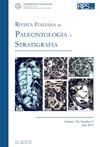加拿大育空地区晚三叠世(norian)介形类:新的分类和古生物地理学见解
IF 1.9
3区 地球科学
Q2 GEOLOGY
引用次数: 3
摘要
目前的工作调查了加拿大育空地区晚三叠纪介形虫的重要性,并增加了诺里安时期这些生物分类学的科学知识,这些生物的分类记录和理解仍然很少。Stikinia地体Lime Peak的15个石灰岩样本代表了不同的海洋古环境,提供了90个物种,其中包括9个新描述的物种:Alatobirdia?sohni n.sp.,Bairdia aksala n.sp.、B.taan n.sp.和B.yukonesis n.sp。相似性分析表明,与珊瑚礁和藻类相关的介形虫组合具有不同的组成。Lime Peak的介形虫-藻类组合表明,Bairdiidae对藻类的亲和力(在Lime Peake的情况下为Dacycladaleans)已经在Norian建立。根据对其他分类群的研究,在Panthalassa东部和西部与日本之间的Norian时期发现了一种动物群联系。晚三叠纪,潘塔拉萨东部和特提斯地区之间的物种流动显得非常不平衡,大多数迁徙都来自特提斯。需要来自其他中、上三叠统潘塔拉萨地区和阶段(即Ladinian和Carnian)的进一步数据来确认这种明显的趋势是由于采样偏差还是反映了真实的扩散通量。本文章由计算机程序翻译,如有差异,请以英文原文为准。
OSTRACODS FROM THE LATE TRIASSIC (NORIAN) OF YUKON, CANADA: NEW TAXONOMIC AND PALAEOBIOGEOGRAPHIC INSIGHTS
The present work investigates the significance of Late Triassic ostracods from the Yukon Territory, Canada, and adds to the scientific knowledge of the taxonomy of these organisms during the Norian, which remain poorly documented and understood. Fifteen limestone samples representing distinct marine palaeoenvironments cropping out at Lime Peak, Stikinia terrane, provided 90 species, including 9 newly described: Alatobairdia? sohni n. sp., Bairdia aksala n. sp., B. taan n. sp., B. yukonensis n. sp., Cornutobairdia yukonella n. sp., Lobobairdia whitella n. sp., Mirabairdia canadia n. sp., Hungarella limella n. sp., Leviella riedeli n. sp. Most assemblages point to neritic conditions in the photic zone. A similarity analysis demonstrates the distinct composition of reef-related and algae-related ostracod assemblages. The ostracod-algae associations in Lime Peak reveal that the affinity of Bairdiidae for algae (Dasycladaleans in the case of Lime Peak) was already established in the Norian. A faunal link is identified during the Norian between eastern and western Panthalassa and Japan, in line with studies on other taxa. The flux of species between eastern Panthalassa and Tethyan areas appears very unbalanced in the Late Triassic with most migrations originating from the Tethys. Further data from other Middle and Upper Triassic Panthalassan localities and stages (i.e. Ladinian and Carnian) are needed to confirm whether this apparent trend is due to sampling bias or reflects real dispersal fluxes.
求助全文
通过发布文献求助,成功后即可免费获取论文全文。
去求助
来源期刊
CiteScore
3.60
自引率
4.30%
发文量
28
审稿时长
>12 weeks
期刊介绍:
The Rivista Italiana di Paleontologia e Stratigrafia was founded in 1895. It publishes original papers dealing with all fields of paleontology and of stratigraphy, from Italy and the Mediterranean to the Tethys, as well across the globe from China to North America.

 求助内容:
求助内容: 应助结果提醒方式:
应助结果提醒方式:


